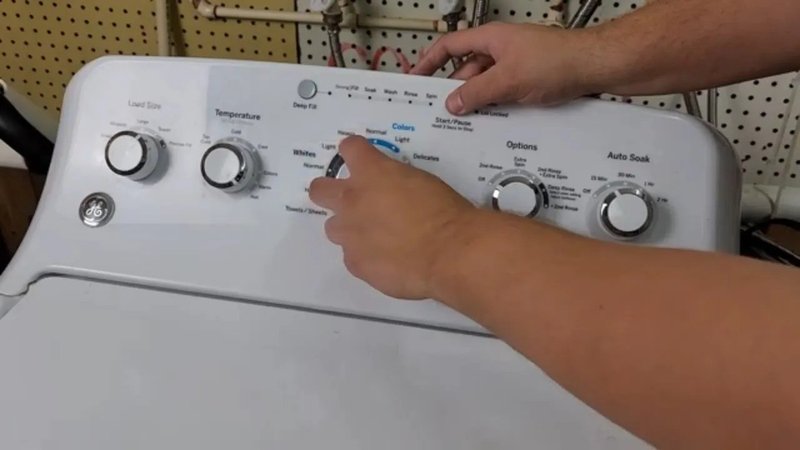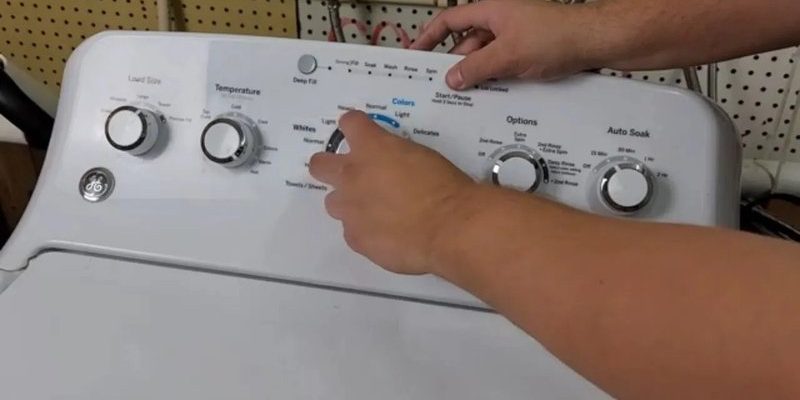
You may have heard people say, “Just reset it!” But is it really that simple? Resetting sounds like a magic button that fixes everything, doesn’t it? However, like closing and reopening a stuck door, resetting might help, but it doesn’t always solve the underlying problem. In this guide, we’ll delve into what the UE error really is, whether a reset can be your quick fix, and what other steps you can take to resolve this pesky issue.
Understanding the UE Error Code
Let’s start with what the UE error code actually stands for. It’s essentially your GE washing machine waving a red flag to indicate that it’s struggling to keep the load balanced during a spin cycle. Imagine trying to spin a weighted hula hoop that’s lopsided – it won’t spin evenly. That’s precisely what’s happening inside your machine. When clothes clump on one side of the drum, the washing machine can’t spin properly, resulting in the UE code.
You might be wondering, “Why does this even happen?” Well, several factors can lead to this imbalance. Overloading the machine is a frequent culprit. Think about stuffing a suitcase: there’s only so much you can pack before it just won’t zip. Similarly, if you pack too many clothes into your washer, the drum struggles to spin. Uneven distribution of clothes, such as one large item mixed with smaller ones, can also throw off the balance.
The machine detecting an unbalanced load is like an alert system. It prevents further damage by stopping the spin cycle. This means the error is a protective measure, safeguarding your appliance from excessive wear and tear. It’s essential to understand this isn’t a flaw, but rather a built-in feature designed to prolong your machine’s life.
Can Resetting Your Washing Machine Fix It?
Here’s the deal: resetting your GE washing machine is often the first go-to solution for many technical glitches, including the UE error code. Just like restarting a sluggish computer, resetting can sometimes clear temporary glitches stuck in the machine’s system. For some users, this action has miraculously resolved the problem, allowing the machine to recalibrate and try again with better results.
To reset, all you generally need to do is unplug the washing machine from the power source for a few minutes and then plug it back in. It’s like giving your machine a short nap to “wake up” refreshed. But, while this can sometimes resolve the error, it’s not a guaranteed solution. If the underlying cause of the imbalance isn’t addressed, the error is likely to return.
Sometimes, the reset doesn’t work because the issue isn’t with the software, but with the load itself. It’s like trying to fix a crooked picture frame by resetting the nail – it might stay straight for a moment, but unless you adjust the picture, it’ll keep tilting. In these cases, manually redistributing the clothes in the drum and checking that the machine isn’t overloaded is crucial.
Steps for Balancing the Load
If resetting doesn’t cut it, you’ll need to roll up your sleeves and balance the load manually. Here’s how you can do it:
1. **Open the machine and redistribute the clothes:** Take a peek inside and see if any garments are tangled or caught on one side. Imagine a seesaw with two unevenly matched kids. You need to make sure the weight is evenly distributed for a smooth ride.
2. **Check the load size:** Your GE washing machine is like a finely tuned instrument. It operates best within certain limits. Ensure you’re not putting in too many heavy items like towels or blankets without smaller, lighter materials to offset the weight.
3. **Run a test spin:** After adjustments, try a spin cycle with the lid open. If it stays balanced, you’ve likely solved the problem. Close the lid and let the machine complete its cycle.
Through these adjustments, you should see fewer UE error codes. It’s all about ensuring balance, both inside and outside the drum. Once you know how to manage the load, your washing machine should run smoothly, minimizing those annoying interruptions.
Preventative Measures to Keep UE Errors at Bay
Preventing the UE error is all about maintaining balance from the start. Think of it like walking a tightrope – preparation and vigilance are key. To keep your laundry tasks frustration-free, there are a few simple habits you can adopt.
First, always check the machine’s capacity before loading it up. Overloading or underloading disrupts the washer’s natural equilibrium. You wouldn’t pack a sandwich bag with a watermelon, right? Equip each load with a variety of garment sizes for better distribution.
Additionally, consider using mesh laundry bags for smaller items. These bags keep little things from being tossed around freely, reducing the chance of them all ending up in one spot. It’s like using a pen holder on a desk – it keeps everything organized.
Lastly, it’s wise to periodically check the machine for any signs of wear or imbalance. Even the best balancers need a check-up now and then. A quick inspection ensures that parts are in good working order, preventing future errors.
Ultimately, while resetting can be a quick-fix solution, actively managing your laundry loads and regularly maintaining your machine will create a harmonious laundry routine free from pesky UE errors. With a bit of attention and effort, you can keep your washing machine working efficiently and extend its lifespan.
